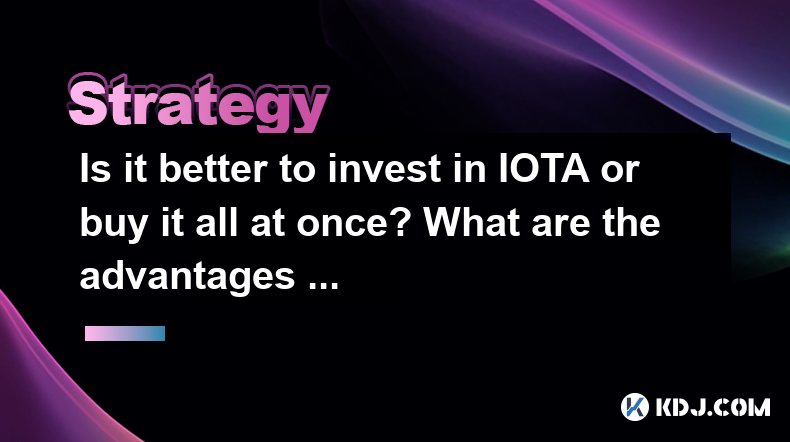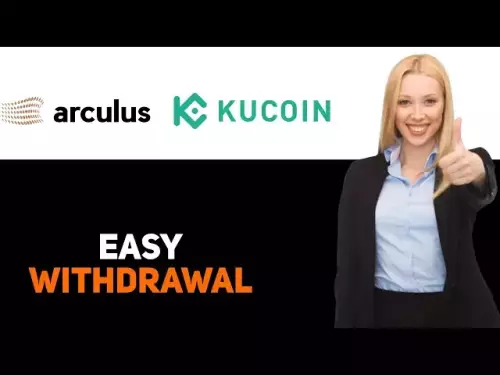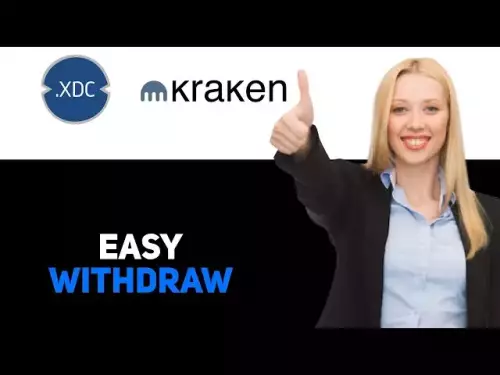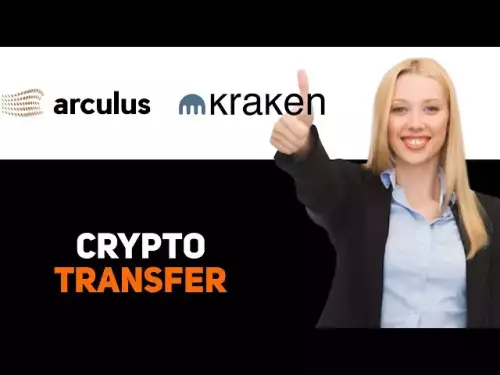-
 bitcoin
bitcoin $114684.631706 USD
-0.87% -
 ethereum
ethereum $4228.677447 USD
1.58% -
 bnb
bnb $1294.880693 USD
-1.16% -
 tether
tether $1.000819 USD
-0.02% -
 xrp
xrp $2.605138 USD
2.79% -
 solana
solana $209.908690 USD
5.89% -
 usd-coin
usd-coin $0.999903 USD
-0.03% -
 dogecoin
dogecoin $0.213423 USD
2.93% -
 tron
tron $0.322721 USD
-0.10% -
 cardano
cardano $0.727247 USD
3.66% -
 hyperliquid
hyperliquid $42.339456 USD
6.05% -
 chainlink
chainlink $19.910811 USD
5.16% -
 ethena-usde
ethena-usde $1.000557 USD
0.00% -
 stellar
stellar $0.349734 USD
2.69% -
 bitcoin-cash
bitcoin-cash $543.848687 USD
-0.21%
Is it better to invest in IOTA or buy it all at once? What are the advantages and disadvantages of each?
IOTA's Tangle technology enables scalability and zero fees, making it ideal for IoT; consider gradual investment to mitigate risk or buy all at once for immediate exposure.
May 05, 2025 at 12:14 am

When considering whether to invest in IOTA gradually or buy it all at once, it's essential to understand the unique aspects of IOTA and the strategies involved in investing in cryptocurrencies. IOTA, known for its Tangle technology, offers a different approach to blockchain with its focus on the Internet of Things (IoT). Let's delve into the advantages and disadvantages of each investment strategy.
Understanding IOTA and Its Unique Features
IOTA stands out in the cryptocurrency world due to its use of the Tangle, a directed acyclic graph (DAG) instead of a traditional blockchain. This technology enables scalability and zero transaction fees, making it particularly suitable for microtransactions and IoT applications. IOTA's focus on machine-to-machine payments and data integrity sets it apart from other cryptocurrencies, which primarily focus on peer-to-peer transactions.
Investing in IOTA Gradually
Investing in IOTA gradually, often referred to as dollar-cost averaging (DCA), involves spreading out your investment over time. This strategy can help mitigate the risk of entering the market at a peak price.
Advantages of Gradual Investment
- Reduced Risk: By spreading out your investment, you reduce the risk of buying a large amount at a peak price. If the price of IOTA fluctuates, you'll buy at various price points, potentially lowering your average cost per IOTA.
- Flexibility: Gradual investment allows you to adjust your strategy based on market conditions. If IOTA's price drops significantly, you can increase your investment to take advantage of lower prices.
- Less Emotional Stress: Investing smaller amounts over time can be less stressful than making a large one-time investment, as you're not as heavily exposed to immediate market volatility.
Disadvantages of Gradual Investment
- Market Timing: While DCA reduces the impact of market timing, it doesn't eliminate it entirely. If the price of IOTA rises steadily over time, you might end up buying at higher average prices than if you had invested all at once.
- Transaction Fees: Depending on the platform you use, you might incur multiple transaction fees, which can add up over time and reduce your overall returns.
- Opportunity Cost: If IOTA experiences a significant price surge shortly after you start investing, you might miss out on potential gains by not having all your funds invested from the start.
Buying IOTA All at Once
Buying IOTA all at once involves investing your entire amount in a single transaction. This approach can be appealing for those who believe in IOTA's long-term potential and want to maximize their exposure from the outset.
Advantages of Buying All at Once
- Immediate Exposure: By investing all at once, you gain immediate full exposure to IOTA's potential price appreciation. If the price rises shortly after your investment, you stand to benefit from the entire increase.
- Simplified Strategy: A one-time investment simplifies your strategy, as you don't need to monitor the market constantly to make additional purchases.
- Lower Transaction Fees: You only incur a single transaction fee, which can be more cost-effective than multiple fees associated with gradual investing.
Disadvantages of Buying All at Once
- Increased Risk: Investing all at once means you're fully exposed to the risk of entering the market at a peak price. If the price of IOTA drops significantly after your purchase, your investment could suffer substantial losses.
- Emotional Stress: A large one-time investment can be emotionally stressful, especially during periods of high volatility. The potential for significant losses might cause anxiety and affect your decision-making.
- Opportunity Cost: If you believe the price of IOTA will decrease in the near future, buying all at once might mean missing out on the opportunity to buy at a lower price.
How to Invest in IOTA Gradually
If you decide to invest in IOTA gradually, here's how you can go about it:
- Choose a Reliable Exchange: Select a reputable cryptocurrency exchange that supports IOTA, such as Binance or Bitfinex. Ensure the exchange has a good track record and offers the necessary security features.
- Set Up Your Account: Register for an account on the chosen exchange. Complete the necessary verification processes to comply with Know Your Customer (KYC) and Anti-Money Laundering (AML) regulations.
- Fund Your Account: Deposit the amount you plan to invest gradually into your exchange account. You can use bank transfers, credit/debit cards, or other supported payment methods.
- Determine Your Investment Schedule: Decide on the frequency and amount of your investments. For example, you might choose to invest a fixed amount weekly or monthly.
- Execute Your Purchases: At each scheduled interval, use the exchange's trading platform to buy IOTA. Monitor the market but stick to your predetermined investment schedule to avoid emotional decision-making.
How to Buy IOTA All at Once
If you prefer to buy IOTA all at once, follow these steps:
- Select a Trusted Exchange: Choose a reliable exchange that offers IOTA, such as Binance or Bitfinex. Consider factors like security, fees, and user experience.
- Create and Verify Your Account: Sign up for an account on the chosen exchange and complete the required verification steps to ensure compliance with KYC and AML regulations.
- Deposit Funds: Transfer the full amount you plan to invest into your exchange account. Use a secure payment method like a bank transfer or a supported cryptocurrency.
- Place Your Order: Once your funds are available, navigate to the trading section of the exchange. Select the IOTA trading pair (e.g., IOTA/BTC or IOTA/USDT) and place a market or limit order to buy IOTA at the current market price or a specified price, respectively.
- Secure Your Investment: After your purchase is complete, consider transferring your IOTA to a secure wallet, such as the official IOTA wallet or a hardware wallet like Ledger, to protect your investment from exchange-related risks.
Factors to Consider When Choosing Your Strategy
When deciding whether to invest in IOTA gradually or all at once, consider the following factors:
- Risk Tolerance: Your comfort level with market volatility will significantly influence your decision. If you're risk-averse, gradual investment might be more suitable, while those with a higher risk tolerance might prefer a one-time investment.
- Market Outlook: Your view on IOTA's future price movements can guide your strategy. If you believe the price will rise steadily, investing all at once might be beneficial. Conversely, if you expect volatility or a potential price drop, gradual investment could be wiser.
- Investment Goals: Consider your investment horizon and goals. If you're looking for long-term growth, either strategy could work, but if you're aiming for short-term gains, your approach might differ.
- Available Capital: The amount of money you have available to invest can also impact your decision. If you have a significant sum to invest, buying all at once might be more practical, while smaller amounts might be better suited for gradual investment.
Frequently Asked Questions
Q: Can I switch between gradual investment and buying all at once during my investment journey with IOTA?A: Yes, you can switch between strategies based on your changing circumstances and market conditions. For example, you might start with gradual investments and decide to buy a larger amount all at once if you believe the price is favorable.
Q: How does IOTA's Tangle technology impact my investment strategy?A: IOTA's Tangle technology, which enables scalability and zero transaction fees, can make it an attractive long-term investment. However, it doesn't directly influence whether you should invest gradually or all at once. Your strategy should be based on your risk tolerance, market outlook, and investment goals.
Q: Are there any tax implications I should consider when investing in IOTA?A: Tax implications can vary based on your jurisdiction. In many countries, cryptocurrencies like IOTA are subject to capital gains tax. Gradual investments might result in multiple taxable events, while buying all at once could lead to a single event. Consult with a tax professional to understand the specific implications in your area.
Q: How can I stay updated on IOTA's developments to inform my investment strategy?A: To stay informed, follow IOTA's official channels, such as their website and social media accounts. Additionally, join IOTA-focused communities and forums, subscribe to cryptocurrency news outlets, and consider using analytics platforms to track market trends and sentiment.
Disclaimer:info@kdj.com
The information provided is not trading advice. kdj.com does not assume any responsibility for any investments made based on the information provided in this article. Cryptocurrencies are highly volatile and it is highly recommended that you invest with caution after thorough research!
If you believe that the content used on this website infringes your copyright, please contact us immediately (info@kdj.com) and we will delete it promptly.
- XRP Price Prediction: Weekend Rollercoaster or Rally?
- 2025-10-12 08:45:16
- Bittensor (TAO): Super Bullish Signals Point to Potential 2x Rally
- 2025-10-11 10:25:12
- Silver Price Correction: Navigating the Dip & Identifying Key SEO Keywords
- 2025-10-11 10:25:12
- Decoding Crypto Trends: Bittensor's Bull Run, Cardano's Dip, and LivLive's Presale Buzz in 'Uptober 2025'
- 2025-10-12 08:45:16
- MoonBull: The Crypto Meme Coin Promising 1000x Gains?
- 2025-10-11 10:30:01
- Crypto Payroll Revolution: Stablecoins, Altcoins, and the Future of Salary Payments
- 2025-10-11 10:30:01
Related knowledge

Practical parameter settings for a Bitcoin multi-timeframe moving average system
Sep 18,2025 at 10:54pm
Optimizing Timeframe Combinations for Bitcoin Trading1. Selecting appropriate timeframes is crucial when building a multi-timeframe moving average sys...

How can I filter out false breakouts in Dogecoin high-frequency trading?
Sep 22,2025 at 01:00am
Understanding False Breakouts in Dogecoin Trading1. A false breakout occurs when Dogecoin's price appears to move beyond a defined support or resistan...

Techniques for identifying tops and bottoms in the Bitcoin on-chain NVT model
Sep 20,2025 at 07:54pm
Understanding the NVT Model in Bitcoin Analysis1. The Network Value to Transactions (NVT) ratio is often described as the 'P/E ratio' of the cryptocur...

What does the surge in open interest in Bitcoincoin futures mean?
Sep 20,2025 at 11:18pm
Understanding the Surge in Dogecoin Futures Open Interest1. A surge in open interest within Dogecoin futures indicates a growing number of active cont...

How can I use the Ethereum USDT premium to gauge market sentiment?
Sep 18,2025 at 11:55pm
Understanding the Ethereum USDT Premium1. The Ethereum USDT premium refers to the price difference between USDT (Tether) traded on Ethereum-based plat...

What should I do if Ethereum staking yields decline?
Sep 20,2025 at 06:18am
Understanding the Causes Behind Declining Ethereum Staking Yields1. The Ethereum network transitioned to a proof-of-stake consensus mechanism with the...

Practical parameter settings for a Bitcoin multi-timeframe moving average system
Sep 18,2025 at 10:54pm
Optimizing Timeframe Combinations for Bitcoin Trading1. Selecting appropriate timeframes is crucial when building a multi-timeframe moving average sys...

How can I filter out false breakouts in Dogecoin high-frequency trading?
Sep 22,2025 at 01:00am
Understanding False Breakouts in Dogecoin Trading1. A false breakout occurs when Dogecoin's price appears to move beyond a defined support or resistan...

Techniques for identifying tops and bottoms in the Bitcoin on-chain NVT model
Sep 20,2025 at 07:54pm
Understanding the NVT Model in Bitcoin Analysis1. The Network Value to Transactions (NVT) ratio is often described as the 'P/E ratio' of the cryptocur...

What does the surge in open interest in Bitcoincoin futures mean?
Sep 20,2025 at 11:18pm
Understanding the Surge in Dogecoin Futures Open Interest1. A surge in open interest within Dogecoin futures indicates a growing number of active cont...

How can I use the Ethereum USDT premium to gauge market sentiment?
Sep 18,2025 at 11:55pm
Understanding the Ethereum USDT Premium1. The Ethereum USDT premium refers to the price difference between USDT (Tether) traded on Ethereum-based plat...

What should I do if Ethereum staking yields decline?
Sep 20,2025 at 06:18am
Understanding the Causes Behind Declining Ethereum Staking Yields1. The Ethereum network transitioned to a proof-of-stake consensus mechanism with the...
See all articles

























![[4K 60fps] Prisma by novichokk (1 Coin) [4K 60fps] Prisma by novichokk (1 Coin)](/uploads/2025/10/14/cryptocurrencies-news/videos/k-fps-prisma-novichokk-coin/68ee49804ba00_image_500_375.webp)
















































